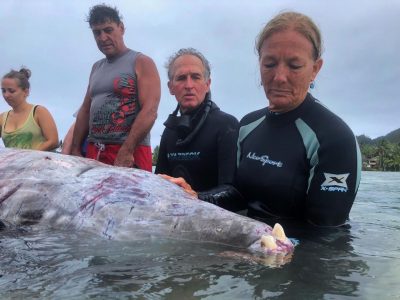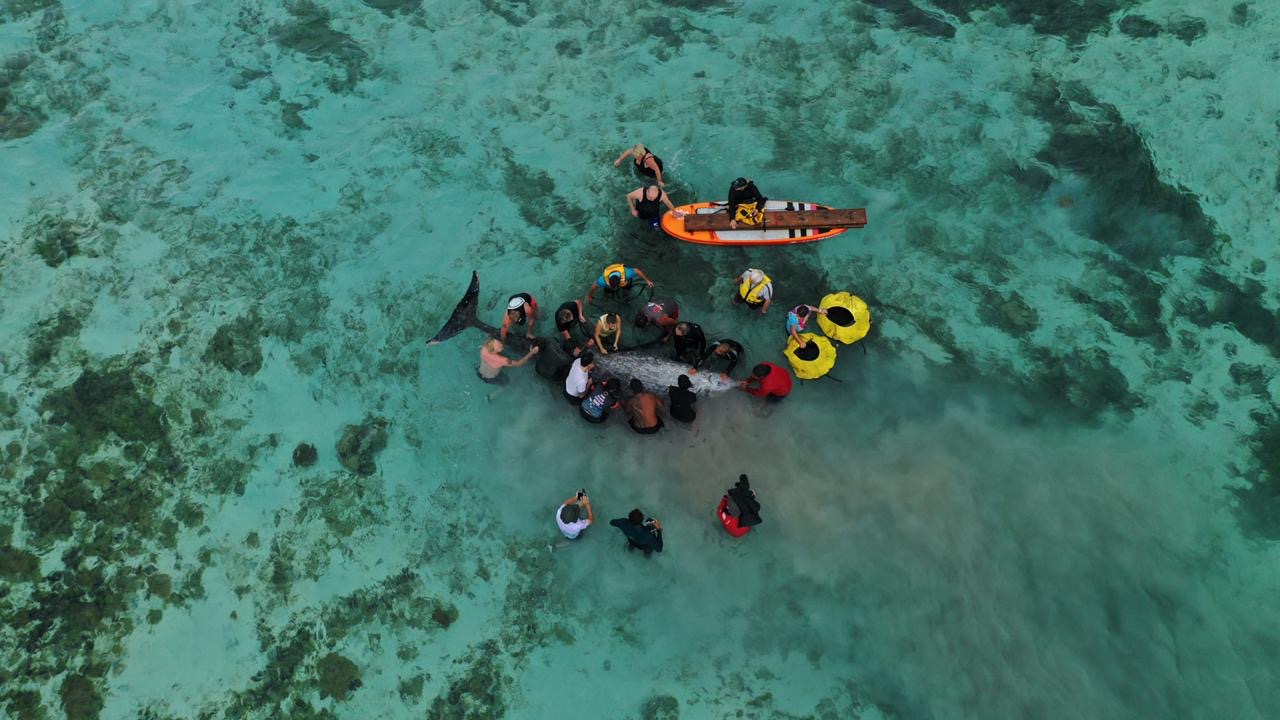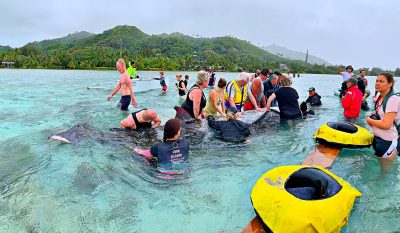I love waking up in the morning and having absolutely no idea what new adventure might present itself. Exhausted from a very busy and intense whale season, we were out in bad weather yesterday hoping to find a singing male humpback. The calls started coming in at about 10:12 AM. “Hello, is this Nan? There’s a whale stranded on the reef at Muri Lagoon!!! Can you please come quickly?” The calls and texts just kept coming in concerning the urgency of this stranded whale. 20 minutes later a text from Josh Mitchell read that the whale was swimming around inside the lagoon! Having two boats on the water already, we drove full speed up along the reef and went into Avana Harbor. Luckily Tom and Lucy were there to pick us up! We had called the rest of our team to meet us at the whale ASAP. They were all there in no time.
 Luckily the owners of Kura’s Kabanas rang us just as we were going past their driveway. They could see the whale in the shallow water of the lagoon from there. I looked out from the shore and could tell immediately that it was a beaked whale. It had turned on its side and was holding its breath. Whales, of course, are mammals and need to be able to breathe air just like us humans. We got to the whale as quickly as possible and turned it so that the blowhole was up. The whale was in dire distress. Amazingly, more and more people showed up and everyone swung into full action! Before I knew it we had a team of locals, Muri businesses, biologists, National Geographic filmmakers, school children, and tourists. We even had a dog out there! The determination of every single person involved was so impressive. To look at all of the healing hands on this very old (probably around 45 to 50 year-old) whale was a beautiful sight. Then there were those that were leading the way by clearing a path through the lagoon so that we could move the whale along towards the pass at Avana Harbour. Everyone was moving rocks and coral to prevent more damage to the whale!
Luckily the owners of Kura’s Kabanas rang us just as we were going past their driveway. They could see the whale in the shallow water of the lagoon from there. I looked out from the shore and could tell immediately that it was a beaked whale. It had turned on its side and was holding its breath. Whales, of course, are mammals and need to be able to breathe air just like us humans. We got to the whale as quickly as possible and turned it so that the blowhole was up. The whale was in dire distress. Amazingly, more and more people showed up and everyone swung into full action! Before I knew it we had a team of locals, Muri businesses, biologists, National Geographic filmmakers, school children, and tourists. We even had a dog out there! The determination of every single person involved was so impressive. To look at all of the healing hands on this very old (probably around 45 to 50 year-old) whale was a beautiful sight. Then there were those that were leading the way by clearing a path through the lagoon so that we could move the whale along towards the pass at Avana Harbour. Everyone was moving rocks and coral to prevent more damage to the whale!
The whale had washed over the reef up by Koromiri Motu. It swam until it was too shallow. When whales strand they go into a stress mode and often die from kidney failure and other organ malfunction . We had to keep this whale calm as everyone moved it a few metres at a time. thank goodness for the brainstorming of Paul Mangakahia who brought the proper cargo nets and carriers to lift this incredibly heavy whale!
The lagoon was full of sharp coral, and the whale was very cut up and bleeding in many spots. But with the efforts of a magnificent team and constant reassurance to the whale with hands, soft voices, and staring into its eye (it was blind in its right eye!), we eventually made it to the opening of the harbor!! Shrieks of joy came from all those involved!
We followed it out to the deep. It swam faster and faster as it realized that it was back into its own territory. Their were many tears of joy. This is the first time in my 30 years of helping stranded animals as part of my research that I have had a successful ending with a beaked whale stranding! We were well overjoyed to know that this great great great grandfather, whose species has been on this planet for tens of thousands of years, was back out in the deep water where it belonged. Thank you to everyone involved! The list is so very long. And a very special thanks to my team… Stan, Marisa, Gracie, George, Eva, Dave, Paul, Nicole, Brian, Adam, Dan, Hayes, Jeremy, Derek, Jaewynn, Tom & Lucy! (more>>>>>)
More about this whale! A Ziphius cavirostris (Cuvier’s Beaked Whale):
In 2014, friends of mine used satellite-linked tags to track Cuvier’s beaked whales off the coast of California. They found that the animals dove up to 2,992 m (9,816 ft) below the ocean surface and spent up to two hours and 17 minutes underwater before resurfacing, which represent both the deepest and the longest dives ever documented by any mammal.
The whales’ rib cages can fold down to reduce pockets of air and decrease buoyancy.
Most studies of their diet have been limited to samples from the stomachs of stranded animals here in the Cook Islands and elsewhere. They appear to feed on cephalopods and small fish, including both bathypelagic and mesopelagic prey.
I will write more about this ancient whale in the coming days!




